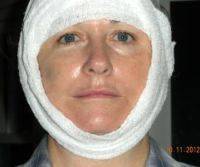Mini Face Lift Recovery Time
There is very little difference in the recovery time for a mini-lift and a face lift.
By repositioning muscles to take tension off of the skin, a facelift with muscle movement (deep plane, SMAS, etc) can diminish the tension on the skin incisions that a mini-lift cannot, long term.
Addressing the ligaments that fall as we age can be addressed and rejuvenating them with a lifting of the muscles in a deeper layer diminishes the pull back in these areas and many surgeons feel that the jowls, neck, and folds can be better addressed.
Mini-lifts are not new procedures (MACS lift = S-Lift with minor variations; LifeStyle lifts are Webster lifts with minor variations; SMAS resections have been around for quite awhile).
Many surgeons, as their experience with facelift procedures grows, feel more comfortable performing more muscle work with their facelifts, and feel that they obtain a better result.
Competence does come with experience and training. Some of the chief advantages of mini-lifts are that
- they are easier to perform for the less experienced surgeon;
- they do not require as much surgical time, so the surgeon can perform more of them and charge the patient less, one of the chief advantages;
- they suit the expectations of many patients.
There is a time and a place for everything and the mini-lift is a good lift for the right patient, just not for all patients.
Mini facelift results
A mini facelift means something different to each surgeon. A mini facelift refers to the incision, not what happens under the skin.
The incision is placed in front of the ear and what happens under the skin is exactly what happens with a standard facelift with repositioning of the muscles and fascia on the side of the face.
As a result, there is marked improvement of the jowls and mid face region. The neck is minimally improved with this procedure so it is a more appropriate procedure for those with early signs of aging.
The recovery time is 7-10 days. Your face may still be a little swollen but not distorted.
Minlifts are great for the appropriate patient. Mild jowling and neck laxity will be improved with this technique.
The problem with minilifts is that many surgeons will try this technique in individuals with more severe changes.
These patients often do better with extended lifts. Minilifts have a quicker recovery. This is due to the fact that less work is done and the post operative changes are less dramatic.
A mini face lift or limited incision face lift produces a rejuvenation of the face, jowl, and cheek area. The results are quite good and recovery takes about 10 days to 2 weeks. The incisions heal well and quickly.
Recovery after a mini facelift in most case is relatively easy, but there will always be a period of social inconvenience. This time period depends both on the skill set and experience of the surgeon, but also on the extent and type of facelift you are having.
A consultation with a BOARD-CERTIFIED PLASTIC SURGEON will give you the best overview of the procedure, it’s expectant results and recuperative period. In general, the minimal downtime is between 7-14 days , although further healing and improvement in your appearance and result continues well in the 3-4 month postoperative period.
Most patients are socially comfortable by this period of time.
Recovery Time for Mini Facelifts
Recovery from mini facelift surgery is relatively straightforward and painless. A bandage may be placed around the face so as to discourage swelling and bruising on the targeted area.
For several days after surgery, the face may feel swollen and taut, although this is a normal reaction.
Notable bruising and swelling typically disappear within 7-10 after surgery, and pain and discomfort typically dissipate several days after surgery. However, if your pain becomes intolerable, then contact your doctor immediately.
While you should make sure to keep your head elevated for 2-3 weeks after surgery, you should be able to return to most daily activities within a day or after surgery.
However, you should plan on taking a week or two off of work. After this recovery period, you can gradually resume all of your former activities.
A mini facelift is a commitment from the standpoint of recovery, since there is no ability to completely conceal the face as you can other areas of the body.
Many patients have enough resolution of facial bruising/swelling such that they can be out at the grocery store with sunglasses by 1 week after surgery.
Cool weather lends itself to this surgery because a scarf can nicely conceal any continued bruising and swelling that has settled in the neck. By 2 weeks, patients can usually return to work. Makeup can be applied after 1-2 weeks.
Biologically, for any scar to fully heal and mature it takes about a year. Over this time you will see your scars become less and less visible as they will lighten in color and become softer to the touch.
With that said, most patients feel comfortable to attend any special engagements such as a wedding by 4 weeks as the majority of swelling has gone down and fine line scars are easily concealed with or without make-up.
In terms of just going out in public without looking like you just had a facelift is frequently possible by 10-14 days when the majority of bruising and swelling has subsided.
Individual patients may have different outcomes, however, most patients would be ready for public appearance by 2 weeks post surgery, often with a little more makeup than usual. Some patients could very well be ready sooner, at 10 days and occasionally even at 1 week.
A lot of this depends on the patients comfort level with possible inquiries from others regarding surgery.
Your Complete Recovery Following Mini Facelift Surgery
Every surgery requires some downtime to get over the initial healing before you feel like you are socially acceptable again.
The mini facelift procedure is no exception. The facelift is usually done as an outpatient surgery, so you can go home that day.
You will wake up with a tight wrap around your head and under your chin. This typically stays on for 24-48 hours depending on the amount of work that had to be done. Once that comes off you may need to wear a spandex and velcro chin strap for a while to help control the swelling.
Typically, it is 24 hours per day for the first week and then nightly for another two weeks. It is important to sleep sitting up or in a recliner chair for the first couple of weeks to help decrease the swelling and speed the healing.
Most people do not feel severe pain from this procedure but rather a dull aching numbness around the cheeks, ears and neck. This usually is worse for the first couple of days but gradually diminishes.
Most patients need their narcotic pain medications for the first day but then typically wean off of them over the next couple of days. By one week out, most patients are only taking a little Tylenol once in a while.
You will be limited in lifting and vigorous exercise for approximately two to three weeks. The stitches in front of the ears usually come out at one week and the ones behind the ear at two weeks.
Timing of going back to work depends on the job. If it is a sedentary job out of the public eye then you will probably feel comfortable going back at one week after surgery, after the stitches are out.
If your job is more strenuous or if you are directly in the public eye then you may feel like you need to take a little bit longer. Usually, people feelcomfortable getting out to the grocery store or to the mall after seven to ten days.
At that point, you may feel more comfortable with a turtleneck or a scarf as there may still be some swelling or bruising around the neck. That tends to resolve by two to three weeks out and can be covered with makeup as soon as the stitches are out.
A mini facelift is a great procedure to freshen your appearance and turn the clock back but it is very important to give yourself enough downtime during the early healing to achieve the best results possible.
Recovery after a mini face lift procedure varies based on what time of procedure was done as well as the individual. In general, most patients need about two weeks to be presentable publicly. This means that you may be able to wear some makeup and most people that do not know you will not know you had anything done unless they are up close.
Beyond this recovery varies depending on bruising and some minor contour irregularity if present. At 6 weeks and beyond you will start to feel like youre most of the way there.
Mini Facelift recovery for public appearances is 2-3 weeks
The majority of the swelling and bruising is gone by 2 weeks after surgery. The swelling and bruising can be sped up by taking arnica and bromelain. At 2 weeks patients can expect to have some lingering fullness in the face.
They should be able to do normal routine activities like going to the grocery store or mall without strangers noticing anything unusual. Acquaintances also would not notice. At 3 weeks, all of the swelling should be gone and their may only be lingering pink color in the incisions.
Women who wear their hair long can easily cover the incisions and those who don’t can still cover this up easily with makeup. Any intimate gatherings with close friends and family can be planned at this time.
The result should lift the cheek and midface and to a lesser extent the lower face. Recovery time is time for bruising and swelling to resolve usually a week to 10 days.
Don’t choose a Facelift procedure by a marketing name. See an experienced, reputable, Board Certified Plastic Surgeon and make sure to explain your exact goals.
Heavily marketed Facelift names designed to minimize the procedure are often misleading. Minor Facelifts will not significantly correct Jowls and loose neck skin.
Facelift Surgery Healing
First make sure your surgeon is Board Certified by the American Board of Plastic Surgery. Mini Facelift is a surgery mostly combined with neck lift surgery where the incisions are made around the ears to elevate and rejuvenate the appearance of the face.
The incisions vary depending on your face and what you would like to improve. Patients will be swollen and healing for the first week in almost all cases, and improving progressively for the next two, and be ready to go out and be seen by the general public by week three.
In many cases, even though one is healed by week three, there is still some improvement in scars and facial form until week six when I think most patients can then be seen for the next big event, be it a wedding, reunion or the like.
Facelift scars, despite the common misperception that they are terrible, are actually almost invisible, and very difficult for anyone to visualize who is not a plastic surgeon.










